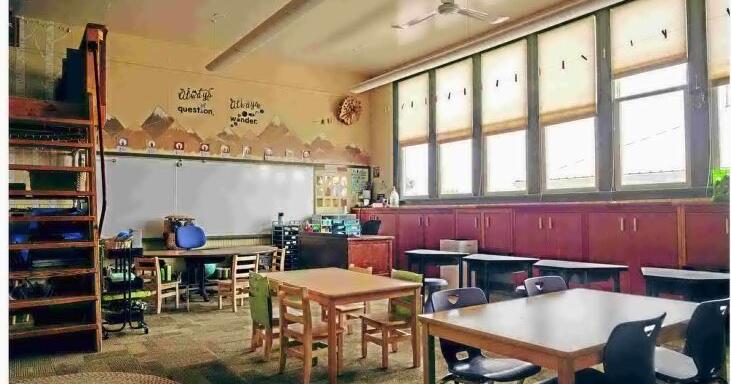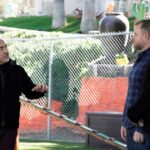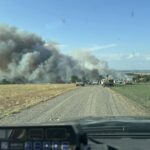“This is the center of Ovando,” Patti Bartlett said, sitting at her desk in the “big room” of the Ovando schoolhouse.
Ovando School celebrated turning 100 this year. It’s grown from a one-room schoolhouse since opening in 1924 to now having an expanded space and recreational areas, but its role as a community anchor in Ovando is unchanged.
“You don’t find that in bigger schools,” Bartlett said. She’s one of the school’s two teachers and instructs fourth through eighth graders.
A formal celebration of the anniversary earlier this month drew a few hundred people. They brought with them dozens of photos of old school classes that former students and families unearthed from attic boxes and storage bins. Some date back to the early 1900s.
“It’s sort of like a big puzzle with everything,” Barb McNally said of putting the school’s timeline together. “Somebody brought in a handful of papers and things recently I haven’t looked through yet, and I’m thinking, ‘Oh wow, there’s another treasure chest!'”
People are also reading…
McNally runs the Brand Bar Museum in Ovando and can tell you just about anything when it comes to the small town’s history. She has old photos on display, along with well-preserved and comprehensive class rosters going back decades.
“Years back the schools were scattered all over the countryside because of transportation,” McNally said of other small schoolhouses that used to be spread around the Upper Blackfoot River area.
“All of the little schools finally either just quit or consolidated with Ovando,” she said.
At its inception, Ovando School was a one-room schoolhouse and a single teacher taught everything to a small group of students. The original schoolhouse was built in 1884, but the school standing today was constructed in 1924.
Newspaper clippings about the school are part of the museum’s collection, too. A story from the Silver State Post in Deer Lodge in 1999 featured Ovando School’s expansion project that added a computer classroom, expanded gym and library to the building.
“We’ve gotten quite a bit of information from newspapers,” McNally said.
Photos and other historical documents from the school will be on display at the museum for the next few months, likely until fall or winter, McNally said. She encouraged people to keep bringing in photos and information so she can keep filling in the school’s timeline.
One hundred years since its opening, the school has been built out more and renovated a number of times. It now includes large recreational areas inside and outside, plenty of storage and learning spaces and a kitchen. It has two full school rooms, the “little room” for kindergarten to third grade and some preschool students, and the room where Bartlett teaches older students.
A gym was added in the early 1970s. It serves as a community space for Ovando for performances and sports, and even serves as the hub for election voting in town, McNally said.
Ovando teachers harness the learning and field trip opportunities that come with the school’s close proximity to the outdoors. Bartlett and Andrea Tougas, who teaches preschool and kindergarten through third grade, will take a group of fourth through eighth graders on an overnight pack trip in the Bob Marshall Wilderness at the end of August.
Bartlett joined Ovando School last year. She previously taught science at Seeley-Swan High School.
“It’s a whole new situation to teach every subject and every grade level,” she said. “Last year my learning curve was huge.”
She’s also on the board of the Blackfoot Challenge, and Bartlett’s love for science is reflected in the curriculum she brings to Ovando’s students. A piece of 3D art covered in painted trout and foliage spans an entire wall of Bartlett’s classroom. It was a final project for the students from a section of curriculum on trout, Bartlett said.
“Kids do their own drawing, their own painting and built that,” she said.
This year, she’s doing “Watershed Wednesdays” where she’ll take students to do water monitoring.
Ovando students participate in a series of events put on by the school every year, including the May Day tea event, Christmas programming and the school’s annual Fourth of July parade, all of which are a big deal in town.
“Not only does the community show up, but all of our kids enthusiastically participate in all of those events,” Tougas said. Each student gets to play an active role in productions, an opportunity that’s sometimes not afforded to students in larger school districts.
Tougas started at Ovando School 10 years ago. Since then, her class size of kindergarten through third graders has grown. She recalled having about five or six students in her first year, compared with 14 enrolled for the upcoming school year. But even as class sizes go up, tight-knit relationships students have with their peers and people around town have been a constant over the last century.
“The concept of community is really built here for students,” she said. “Whether or not they’ve left Ovando, community becomes a core value to them.”
A few years back, Tougas organized a project for students that folded Ovando history into creating community-based art installations.
Those pieces are now scattered around town. They’re large posters with hand-painted figures mounted on pieces of wood with written information sharing Ovando history. Tougas said they sourced materials to reuse and had students research historical figures with McNally. They worked in groups to build the creations and used power tools to install them.
The posters are still up and Tougas hopes they stay that way for as long as they can be maintained as another way to preserve the school and town’s rich history.
She was at the school’s celebration this month and said it was fascinating to hear everything former students remembered from their years at the school.
“A lot of people are blown away at how much the community shows up and supports school and education,” Tougas said. “That hasn’t changed in the last 100 years.”
Zoë Buchli is the education reporter for the Missoulian.





